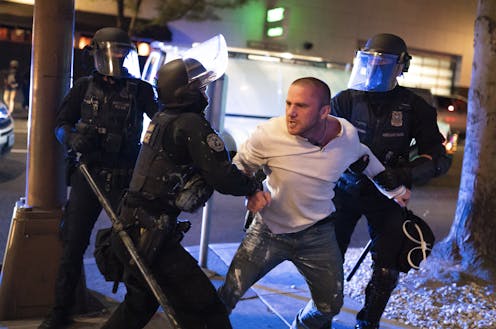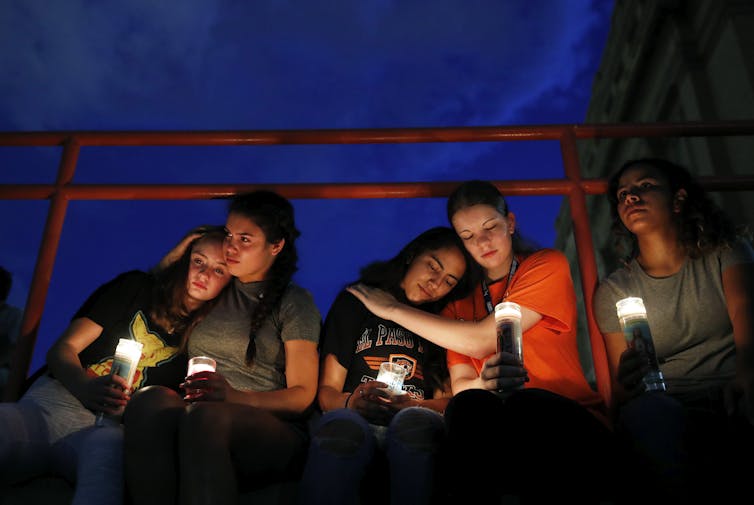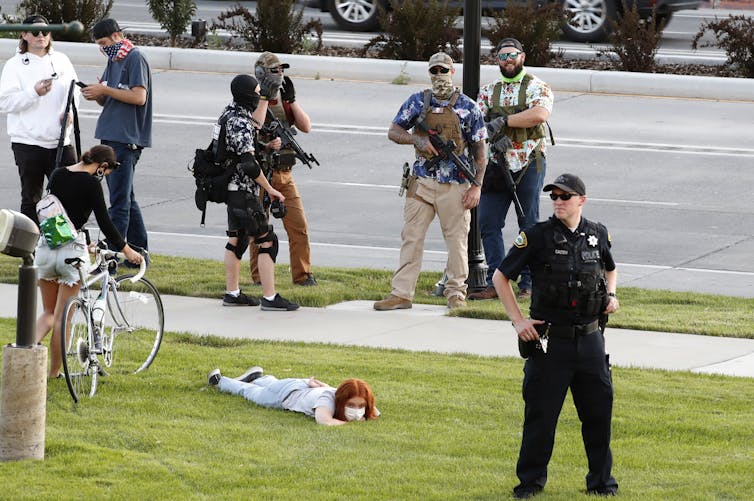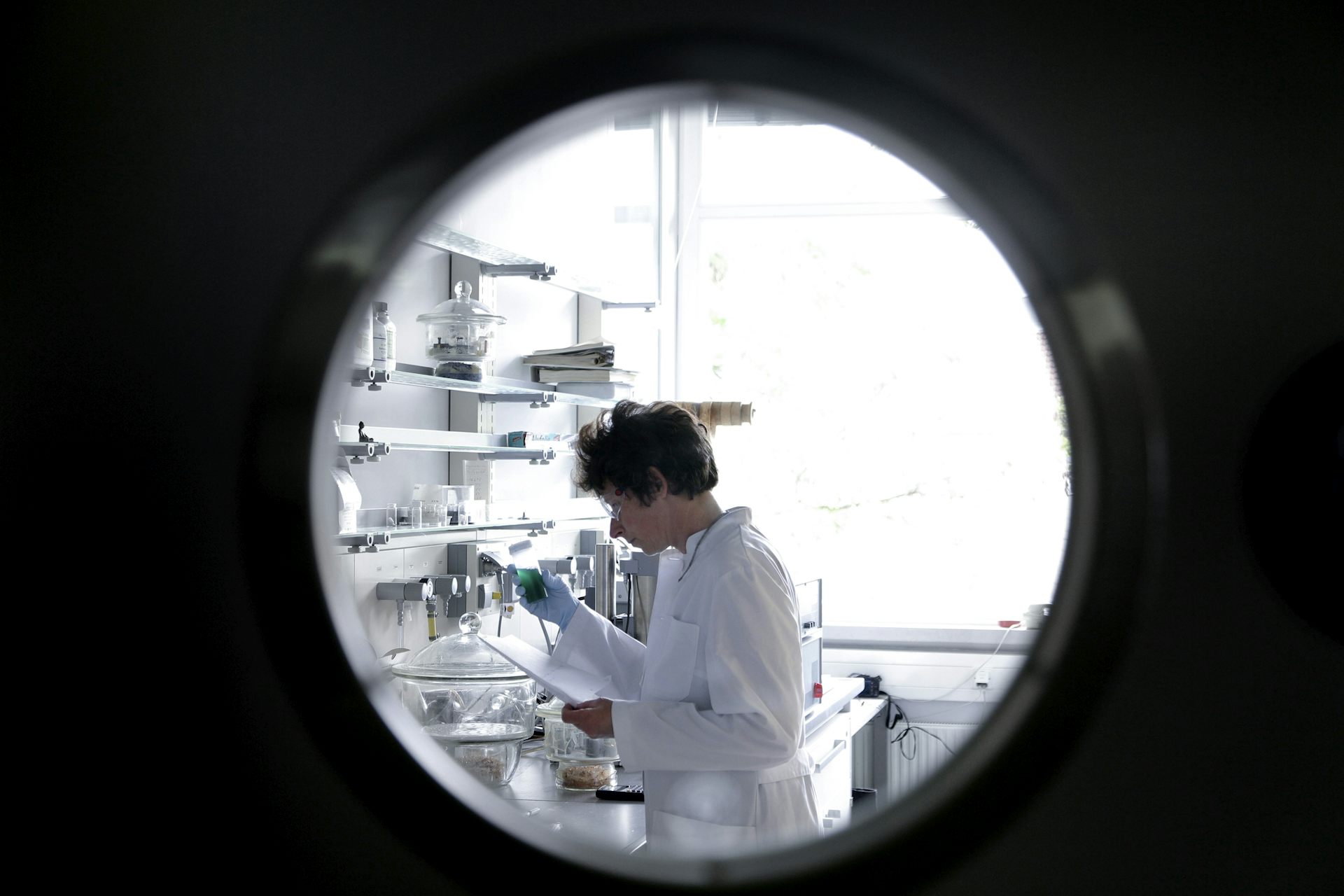Portland and Kenosha violence was predictable – and preventable
The increasing visibility of a wide range of militia and vigilante groups has repeatedly caught local communities and national leaders off guard.

The U.S. reached a deadly moment in protests over racial injustice, as back-to-back shootings in Kenosha, Wisconsin, and Portland, Oregon, on Aug. 25 and 29 took the lives of three people and seriously injured another.
It was tragic – but not surprising.
The alleged shooters were at the protests for different reasons: One was a pro-police supporter who believed he was protecting local businesses in Kenosha and the other an “antifa supporter” and “fixture of anti-police demostrations” in Portland. The victims included apparent supporters of Black Lives Matter protests and a supporter of a far-right group. Together, they reflect an escalating risk of spontaneous violence as heavily armed citizen vigilantes and individuals mobilize at demonstrations and protests.
As a scholar of extremism and director of the Polarization and Extremism Research and Innovation Lab at American University, I have spent the past few months watching people mobilize across the political spectrum – about Second Amendment rights, state shelter-in-place orders and police brutality, and in reaction to those protests – while leaders respond insufficiently to the threat of violence.
Foreseeable conflict
I wasn’t the only one expecting violence. In mid-July, terrorism expert J.J. McNab testified before Congress about her concern “that there will be a shootout at one or more of the Black Lives Matter protests,” warning of the dangers of having heavily armed groups with conflicting goals at the same events.
The danger existed long before that, though. In my new book, “Hate in the Homeland: The New Global Far Right,” I explain that the past three years – from the Charlottesville “Unite the Right” rally in 2017, through mass shootings in Pittsburgh and El Paso to this more recent violence – have shown the growing activity of the extremist fringe in U.S. society.
Yet over the past year, the presence of a wide range of militia and vigilante groups has repeatedly caught local communities and national leaders unprepared to handle the threat they pose.
The pandemic has changed some things: The threat from planned extremist violence, like in Christchurch, New Zealand in March 2019 and Poway, California the following month, is probably lower now – in part because there are fewer large public gatherings for extremists to target. But the threat of spontaneous violence – especially at protests organized around racial injustice and police brutality – is high.

Militia and vigilante groups’ conflicting goals
Americans’ collective inaction to stem the growth of militia and vigilante groups is, in part, rooted in confusion about their goals.
Extremist and paramilitary groups in the U.S. are motivated by a wide range of competing factors. Some are white supremacists seeking to spark a race war. Others are fighting a government they perceive to be tyrannical. Still others are oriented around vigilante support for or defense of local businesses and law enforcement.
Left-wing militias have also grown in recent years, primarily organized around resistance to the far right. These include the recently formed Not F**cking Around Coalition, a Black militia group that has shown up at protests this summer to challenge white supremacists.
At this summer’s protests, that division has been on clear display. Even within groups that ostensibly share the same goals – such as the Boogaloo bois, who call for revolution or civil war – there is little alignment.
In late May, three alleged members of the Boogaloo movement were arrested in Las Vegas for allegedly plotting to spark violence at a Black Lives Matter protest. But a month later in Richmond, Boogaloo groups marched alongside Black protesters and chanted to “drown out the white supremacists” who showed up.
Despite their conflicting goals, militia and vigilante groups all share a sense of dire threat and a belief that their lives, their future survival or people they want to protect are threatened by some outside group. This is “us versus them” thinking at its most extreme; militias feel compelled to defend against those threats.

Conditions ripe for online radicalization
Extremists thrive when people feel uncertain and isolated. They invite new members to join a community and engage heroically to thwart a pressing threat. One review of existing literature finds that almost all recent research finds the “need for belonging” is key to extremism, along with a need for control.
That’s why the current moment is a tinderbox for paramilitary and extremist growth. Millions of Americans are anxious about an unseen virus, are isolated during shutdowns, face widespread economic uncertainty and are spending much more time online, where encounters with propaganda and misinformation are more likely.
During the COVID-19 pandemic, there has been explosive growth in radical political groups, civilian militia, vigilante and conspiracy group membership on social media – across the ideological spectrum. Earlier this summer, Facebook banned hundreds of accounts associated with the far-right “boogaloo” scene, which advocates for revolution and civil war. Last month, Facebook removed nearly 10,000 QAnon groups and 980 “offline anarchist groups,” including some that “identify as Antifa.”
Social media plays a role in the radicalization of 90% of recent extremists in the U.S. The current situation is no exception.
Throughout the spring and summer of 2020, across the country, heavily armed vigilante and militia members responded to incendiary calls to action and to misinformation on social media related to state regulations on gun ownership, shelter-in-place orders and, finally, Black Lives Matter protests. Calls have gone out to “armed citizens to protect our lives and property” to show up at protests to defend against “evil thugs.”
In Kenosha, local law enforcement legitimized vigilante and militia presence by thanking them for being there. “We appreciate you guys,” one police officer in an armored vehicle says on a widely circulated video as he tossed a water bottle to armed militia members. Thanking citizen vigilantes for their support essentially empowers individuals to take matters into their own hands.
Under these conditions, if there’s anything surprising about the violence that has erupted, it’s that it took so long for it to happen.
What can be done?
There are several ways to reduce the threat of future violence, but they all include minimizing the number of people who feel empowered – by local authorities or elected officials – to act violently.
Leaders at all political levels could affirm people’s right to protest peacefully while unequivocally condemning vigilante and militia mobilization, regardless of the reason. Many studies have found that incendiary or hateful rhetoric from politicians both deepens political polarization and increases support for political violence. Research in Germany has shown that when politicians use incendiary language, violence increases. But when they use different words, violence drops.
If public rhetoric doesn’t cool down, I expect escalating polarization and politicization of the protests and vigilante violence may make matters worse in the coming months. I’m particularly concerned because firearms purchases have skyrocketed during the pandemic.
[Deep knowledge, daily. Sign up for The Conversation’s newsletter.]
However, communities could work to interrupt the radicalization of young people, and adults. My own research lab recently released a guide for parents and caregivers to online radicalization, in collaboration with the Southern Poverty Law Center, in order to better help recognize risk and build resilience to extremist narratives during the COVID-19 pandemic. This fall we will study how tools like that affect parents’ abilities to intervene at early stages of radicalization.
Our aim is to reduce the chances of people adopting extremist views and joining militia or vigilante groups in the first place. After all, having fewer extremists seems likely to reduce extremist violence.
Cynthia Miller-Idriss does not work for, consult, own shares in or receive funding from any company or organization that would benefit from this article, and has disclosed no relevant affiliations beyond their academic appointment.
Read These Next
RFK Jr. wants to scrutinize the vaccine schedule – but its safety record is already decades long
Federal officials are questioning the safety of the vaccine series children receive. Here’s the story…
There’s little evidence tech is much help stopping school shootings
The $4 billion school security industry can’t back up claims for its tech. The silver lining: That’s…
Sudan’s civil war: A visual guide to the brutal conflict
Since fighting broke out in April 2023, some 150,000 people have been killed in Sudan and an estimated…





